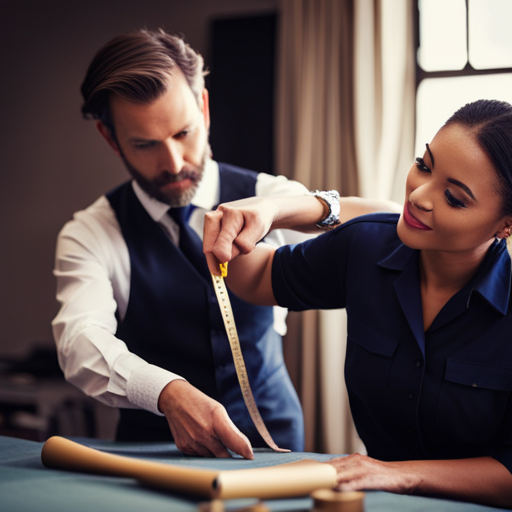Balancing Aesthetics and Functionality in Costume Design

Did you know that the average Broadway costume consists of over 25 different components, each carefully designed to balance aesthetics and functionality?
In the world of costume design, creating visually stunning attire that also allows performers to move with ease is an intricate art.
From understanding a character’s needs to collaborating with directors, this article delves into the creative and practical considerations that go into crafting costumes that truly bring a character to life on stage.
Understanding the Character’s Needs
Understanding the character’s needs is paramount in creating costumes that enhance the storytelling and bring depth to the performance. Character psychology plays a crucial role in costume design. By delving into the psyche of the character, costume designers can craft attire that not only reflects the character’s personality but also aids the actor in embodying their role.
Whether it’s the choice of colors, textures, or styles, each element must align with the character’s inner workings, helping the audience to connect with the narrative on a deeper level.
Moreover, historical context is another essential factor. Costumes must be historically accurate to effectively transport the audience to a specific time and place. They should seamlessly blend with the overall production design, enhancing the visual appeal while staying true to the era being portrayed.
Incorporating historically accurate elements not only adds authenticity but also provides valuable insights into the societal norms and values of the time, enriching the audience’s understanding of the narrative.
Material Selection and Durability
Crafting costumes that effectively balance aesthetics and functionality requires careful consideration of material selection and durability, essential for bringing the character to life on stage or screen.
Material selection plays a pivotal role in the performance of a costume. The chosen fabrics need to withstand the demands of the production, including movement, climate, and potential damage. Durability and comfort are essential factors to consider when selecting materials.
The costume designer must assess the character’s physical activities and emotional journey to ensure that the chosen fabrics can endure the wear and tear of performances while providing the actors with the necessary comfort to deliver their best performance. Additionally, the material should enhance the overall performance by draping, flowing, or shaping in a way that complements the character’s movements and emotions.
A balance between durability and comfort is crucial, as it directly impacts the actor’s ability to inhabit the character authentically and convincingly. Ultimately, the careful selection of materials contributes significantly to the overall success and impact of the costume design.
Incorporating Movement and Flexibility
To ensure costumes allow for natural and unrestricted movement, costume designers prioritize incorporating fabrics that offer flexibility and fluidity, enhancing the performers’ physical portrayal of the character. However, this presents design challenges as the fabrics must not only provide the necessary stretch and give but also withstand the rigors of performance. Creative solutions often involve the use of innovative stretch materials such as spandex blends or athletic performance fabrics that offer the desired flexibility without compromising durability.
Incorporating movement and flexibility also requires a delicate balance between artistic expression and practical considerations. Designers must consider how the chosen fabrics will drape, flow, and move with the performer while also meeting the specific aesthetic requirements of the character and production. Additionally, practical considerations such as maintenance and costume care come into play, as the fabrics must be able to withstand frequent use, washing, and potential alterations without losing their flexibility or shape.
Ultimately, the successful incorporation of movement and flexibility in costume design requires a thoughtful blend of creativity, technical expertise, and a deep understanding of the practical demands of performance.
Visual Impact Vs. Practicality
Incorporating movement and flexibility into costume design necessitates balancing visual impact with practicality, ensuring that the costumes not only enhance the aesthetic appeal of the production but also meet the functional demands of performance. Achieving this balance is crucial for the overall success of a theatrical or dance production.
Here are four key considerations when balancing visual impact with practicality in costume design:
-
Material Selection: Choosing the right fabrics and materials is essential to achieve both visual appeal and functionality. The fabrics must not only look stunning under stage lights but also allow for ease of movement and breathability for the performers.
-
Construction Techniques: Employing advanced construction techniques such as strategic seam placement, adjustable closures, and hidden reinforcements can enhance the visual impact of the costumes while ensuring that they are durable and allow for a wide range of motion.
-
Weight and Mobility: Balancing the visual elements with the weight of the costumes is crucial to ensure that they do not hinder the performers’ mobility. Lightweight yet visually striking costume elements can contribute to the overall aesthetic appeal without compromising functionality.
-
Safety and Durability: Prioritizing the safety and durability of the costumes is essential for performers. Incorporating visual elements in a way that does not pose any safety risks and ensures that the costumes can withstand the rigors of live performances is paramount to achieving the delicate balance between visual impact and practicality.
Collaborating With Performers and Directors
When collaborating with performers and directors, it is essential to integrate their input during the costume design process to ensure seamless coordination between artistic vision and practical performance requirements.
The collaborative process involves open communication and active participation from all involved parties. Costume designers should engage in meaningful discussions with performers and directors to understand their vision for the characters and the overall production. This involves actively listening to their ideas, concerns, and preferences, and incorporating these insights into the costume design.
Communication strategies such as mood boards, sketches, and fabric swatches can aid in conveying design concepts and gathering feedback from performers and directors.
Additionally, costume fittings and rehearsals provide valuable opportunities to fine-tune the costumes based on the performers’ feedback and movement requirements.
Frequently Asked Questions
How Does Costume Design Affect the Overall Atmosphere and Mood of a Production?
Costume design significantly influences a production’s atmosphere and mood through the impact of color and texture on emotions. Balancing functionality and style is crucial, as practicality enhances the performers’ comfort and movement, while aesthetics contribute to the overall visual impact.
What Are Some Innovative Ways to Incorporate Technology Into Costume Design Without Sacrificing Functionality?
Incorporating smart fabrics and wearable tech in costumes is revolutionizing the entertainment industry. The seamless fusion of technology with traditional costume design not only enhances visual appeal but also elevates functionality, creating immersive experiences for audiences.
How Do Costume Designers Navigate Cultural Sensitivity and Authenticity When Creating Costumes for Diverse Characters?
When creating costumes for diverse characters, costume designers navigate cultural sensitivity and authenticity by conducting thorough research, consulting with cultural experts, and incorporating traditional elements while avoiding stereotypes. Cultural representation and costume authenticity are paramount in creating impactful and respectful designs.
What Considerations Are Taken Into Account When Designing Costumes for Outdoor Performances or Extreme Weather Conditions?
When designing costumes for outdoor performances or extreme weather conditions, factors like costume durability, adaptability for performance, and functionality versus aesthetics are crucial. The costumes need to withstand the elements while enhancing the visual impact of the performance.
How Can Costume Designers Balance the Historical Accuracy of Costumes With the Practical Needs of Modern-Day Performers?
Costume designers must carefully balance historical accuracy with modern-day performers’ practical needs. This involves meticulous research to ensure authenticity while prioritizing performer comfort and mobility. Innovative design techniques and materials play a crucial role in achieving this delicate balance.
Conclusion
In the delicate dance of costume design, balancing aesthetics and functionality is like finding the perfect harmony in a symphony. Understanding the character’s needs, selecting durable materials, and incorporating movement and flexibility are essential elements in creating a visually impactful yet practical costume.
Collaboration with performers and directors is crucial in achieving this delicate balance. Just as a skilled conductor leads an orchestra to create a beautiful and cohesive sound, a talented costume designer orchestrates the perfect balance between form and function.

Rufus Whitver is a passionate costume artisan and the creative mind behind layuo.com. With a keen eye for detail and a flair for imaginative design, Rufus brings characters to life through the art of costume making. His expertise encompasses a wide range of styles, from historical recreations to fantastical creations. Through layuo.com, Rufus shares insights, tutorials, and a portfolio showcasing his exceptional craftsmanship, inspiring fellow enthusiasts to embark on their own journey into the world of stunning costumes.



